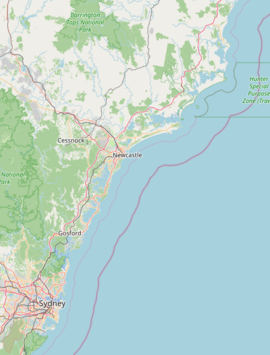Wyee, New South Wales facts for kids
Quick facts for kids WyeeGreater Newcastle, New South Wales |
|||||||||||||||
|---|---|---|---|---|---|---|---|---|---|---|---|---|---|---|---|
| Population | 2,909 (2021 census) | ||||||||||||||
| Postcode(s) | 2259 | ||||||||||||||
| Elevation | 25 m (82 ft) | ||||||||||||||
| Location | |||||||||||||||
| LGA(s) | City of Lake Macquarie | ||||||||||||||
| Region | Hunter | ||||||||||||||
| Parish | Morisset | ||||||||||||||
| State electorate(s) | Lake Macquarie | ||||||||||||||
| Federal Division(s) | Shortland | ||||||||||||||
|
|||||||||||||||
Wyee (pronounced WHY-ee) is a small town in New South Wales, Australia. It is located in the Hunter area, which is part of the City of Lake Macquarie. Wyee is close to the Sydney-Newcastle Freeway. It also has a railway station that opened in 1892. This station is on the NSW TrainLink's Central Coast & Newcastle Line.
Wyee's population has changed over time. In 2001, about 1,487 people lived there. This number grew to 2,588 in 2011. By 2016, it went down slightly to 2,406. The latest count in 2021 shows that Wyee has a population of 2,909 people.
The name "Wyee" comes from the Awabakal Aboriginal language. The Awabakal people are the traditional owners of this land. In their language, "Wyee" means "fire" or "place of bushfires."
History of Wyee
Wyee is located on the traditional lands of the Awabakal people. As mentioned, its name is an Aboriginal word meaning "place of bushfires."
The town got its name from the Wyee railway station. When the station first opened, the area was called Norahville. This name came from a nearby coastal village. In 1887, when the Main Northern railway line was completed, the area was renamed Wyee.
In 1839, a kind person named Thomas Walker was given 1120 acres (about 4 square kilometers) of land in the Wyee area. He tried to improve the land, but he never lived there. Because of this, the land eventually went back to the Morisset Parish.
Community Services and Development
For a long time, some parts of Wyee, especially an area called 'West Wyee', did not have modern services. People in West Wyee lived in an informal settlement. This meant they did not have proper water or sewer systems. This area was divided into smaller plots in 1914, but it was not planned for homes to be built there.
Wyee is part of the City of Lake Macquarie local government area. However, it used to lack a connection to a main sewer system. There are sewage treatment plants nearby, but Wyee itself was not connected.
Good news came in 2021 when a new sewer system was built for the town. About 400 properties were connected to this new system. At first, wastewater was removed by trucks from a pump station. Then, in 2023, a link was completed to the Dora Creek Wastewater Treatment Works. This means wastewater can now be properly treated.
Mining in Wyee
Wyee was once home to a coal mine called Wyee Colliery. This mine was owned by the state and operated from 1962 to 2002. After a short break, the mine reopened in 2004-2005. It was renamed Mannering Colliery and is now operated by the Centennial Coal Company.


